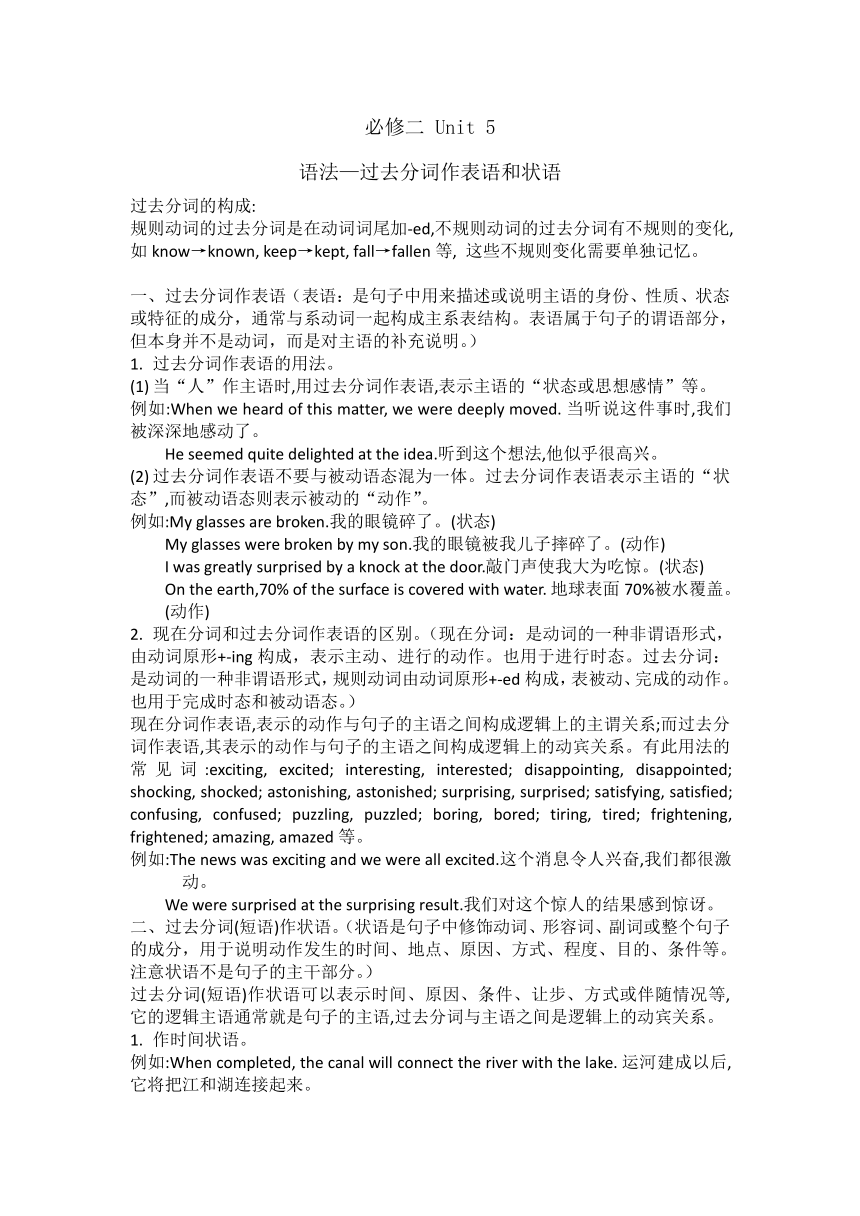
必修二 Unit 5 语法—过去分词作表语和状语 过去分词的构成: 规则动词的过去分词是在动词词尾加-ed,不规则动词的过去分词有不规则的变化,如know→known, keep→kept, fall→fallen等, 这些不规则变化需要单独记忆。 过去分词作表语(表语:是句子中用来描述或说明主语的身份、性质、状态或特征的成分,通常与系动词一起构成主系表结构。表语属于句子的谓语部分,但本身并不是动词,而是对主语的补充说明。) 过去分词作表语的用法。 当“人”作主语时,用过去分词作表语,表示主语的“状态或思想感情”等。 例如:When we heard of this matter, we were deeply moved. 当听说这件事时,我们被深深地感动了。 He seemed quite delighted at the idea.听到这个想法,他似乎很高兴。 过去分词作表语不要与被动语态混为一体。过去分词作表语表示主语的“状态”,而被动语态则表示被动的“动作”。 例如:My glasses are broken.我的眼镜碎了。(状态) My glasses were broken by my son.我的眼镜被我儿子摔碎了。(动作) I was greatly surprised by a knock at the door.敲门声使我大为吃惊。(状态) On the earth,70% of the surface is covered with water. 地球表面70%被水覆盖。(动作) 现在分词和过去分词作表语的区别。(现在分词:是动词的一种非谓语形式,由动词原形+-ing构成,表示主动、进行的动作。也用于进行时态。过去分词:是动词的一种非谓语形式,规则动词由动词原形+-ed构成,表被动、完成的动作。也用于完成时态和被动语态。) 现在分词作表语,表示的动作与句子的主语之间构成逻辑上的主谓关系;而过去分词作表语,其表示的动作与句子的主语之间构成逻辑上的动宾关系。有此用法的常见词:exciting, excited; interesting, interested; disappointing, disappointed; shocking, shocked; astonishing, astonished; surprising, surprised; satisfying, satisfied; confusing, confused; puzzling, puzzled; boring, bored; tiring, tired; frightening, frightened; amazing, amazed等。 例如:The news was exciting and we were all excited.这个消息令人兴奋,我们都很激动。 We were surprised at the surprising result.我们对这个惊人的结果感到惊讶。 过去分词(短语)作状语。(状语是句子中修饰动词、形容词、副词或整个句子的成分,用于说明动作发生的时间、地点、原因、方式、程度、目的、条件等。注意状语不是句子的主干部分。) 过去分词(短语)作状语可以表示时间、原因、条件、让步、方式或伴随情况等,它的逻辑主语通常就是句子的主语,过去分词与主语之间是逻辑上的动宾关系。 作时间状语。 例如:When completed, the canal will connect the river with the lake. 运河建成以后,它将把江和湖连接起来。 作原因状语。 例如:Lost in deep thought, I didn't notice what was happening outside.(Lost in deep thought=Because I was lost in deep thought)由于陷入沉思,我没注意到外面正在发生什么事情。 作条件状语。 例如:Given another hour, I can also work out this problem.(Given another hour=If I am given another hour)如果再给我一个小时,我也能把这道题算出来。 作让步状语。 例如:Beaten by the opposite team, we didn't lose heart and encouraged each other.(Beaten by the opposite team=Though we were beaten by the opposite team)虽然被对方的队打败了,但我们并没有灰心,而是相互鼓励。 作方式或伴随状语。 如:The old man got on the bus,supported by a girl.(supported by a girl作方式状语)在一位姑娘的搀扶下,老人上了公共汽车。 现在分词和过去分词作状语的区别。 过去分词与句子的主 ... ...
~~ 您好,已阅读到文档的结尾了 ~~